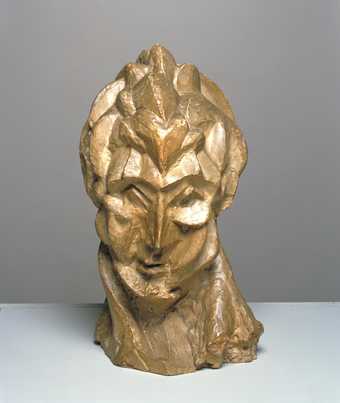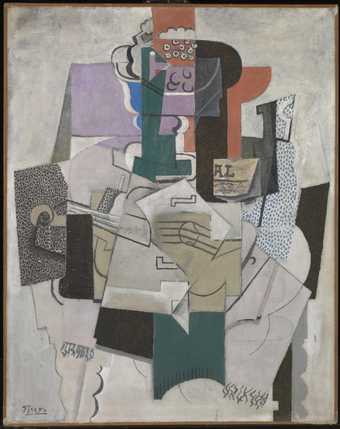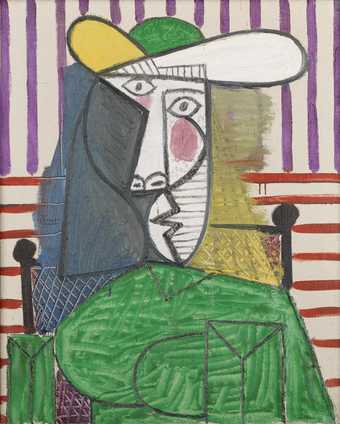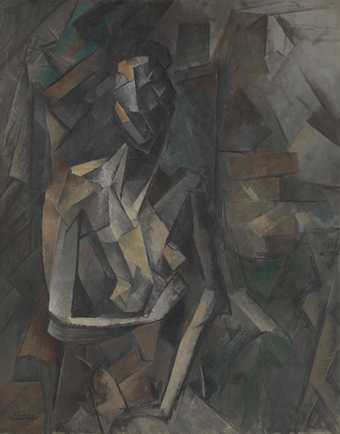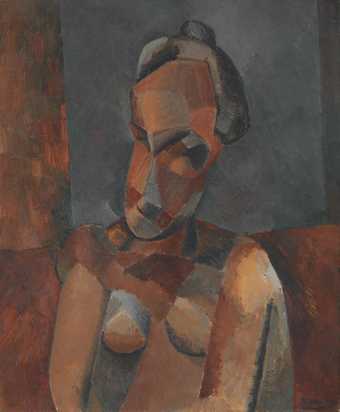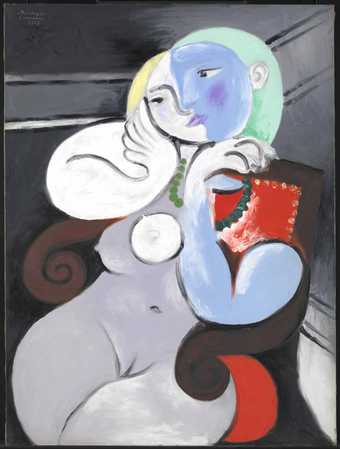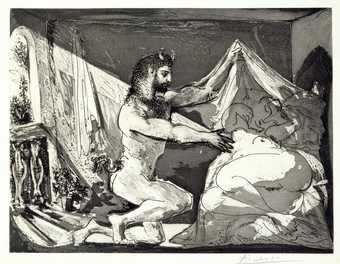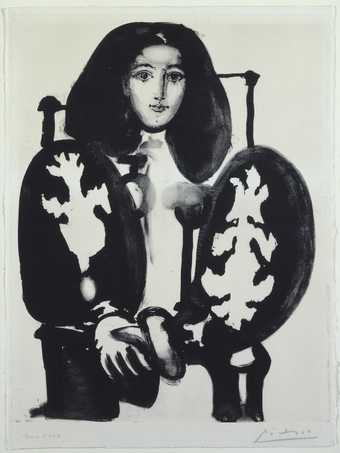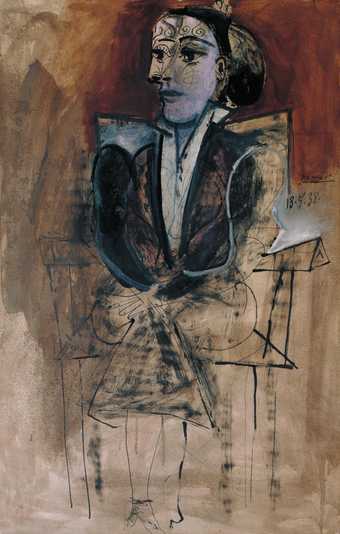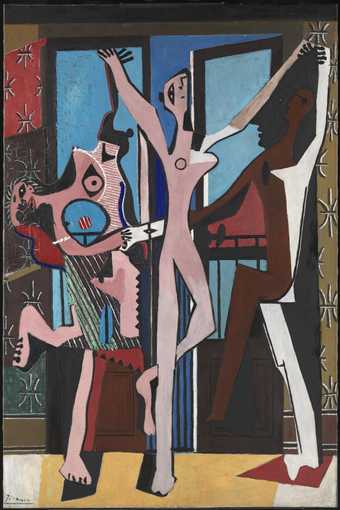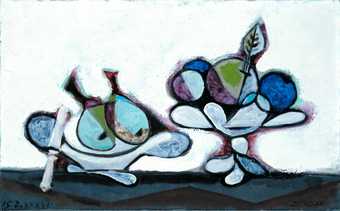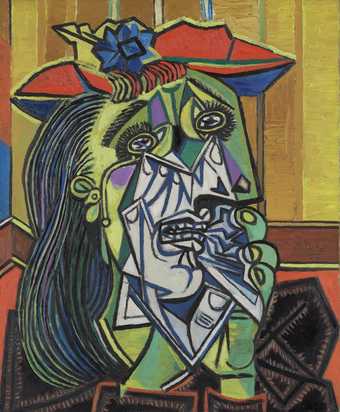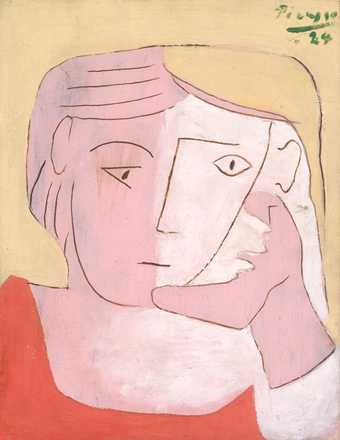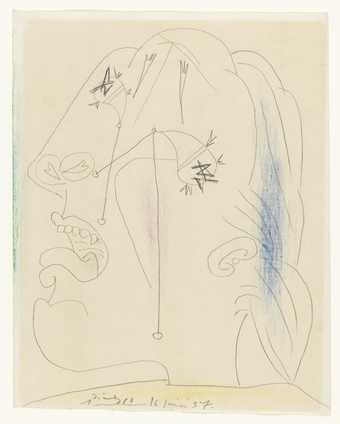
Not on display
- Artist
- Pablo Picasso 1881–1973
- Original title
- Femme en chemise assise
- Medium
- Oil paint on canvas
- Dimensions
- Support: 921 × 730 mm
frame: 1156 × 960 × 70 mm - Collection
- Tate
- Acquisition
- Bequeathed by C. Frank Stoop 1933
- Reference
- N04719
Summary
Seated Woman in a Chemise is an oil painting on canvas by Pablo Picasso. This large portrait features a seated woman at the centre of the canvas. She is presented in three-quarter length format and the upper part of her body is angled slightly away from the viewer, towards the right of the composition. Her gaze is directed outwards but not at the viewer: instead she seems to concentrate on a location to the viewer’s right. The sitter wears the white chemise indicated in the title, which falls seductively off her right shoulder. Her right arm rests on a support, which is also covered in a white fabric. Her left arm rests casually on her thigh, which is slightly raised, and her hands meet lightly in the bottom left corner of the image. The sitter’s long dark hair is pulled away from her face and flows down her back. The lower half of her face is in shadow, although a slight smile seems to animate her lips. The portrait is set against a light blue background, which darkens slightly around the subject’s head. The painting is signed ‘Picasso’ in the bottom left corner.
Picasso painted Seated Woman in his studio on the Rue de la Boëtie, Paris in 1923. The portrait was produced by applying oil paint to canvas, often using quick brushstrokes such as those visible in the white of the sitter’s garment. Although conservator Fotini Koussiaki has noted that ‘Picasso didn’t follow a systematic application of successive paint layers to the stretched canvas’, in 1999 radiography revealed an underpainting, also a portrait, which Picasso incorporated into the final image (Fotini Koussiaki, ‘“My Picture is a Sum of Destructions”, Pablo Picasso (1881–1973)’, Conservation Journal, no.34, Spring 2000, http://www.vam.ac.uk/content/journals/conservation-journal, accessed 9 March 2016.
Within Picasso’s diverse artistic production, Seated Woman is a key example of what art historian Christopher Riopelle has described as the artist’s ‘neo-classical’ style, which Picasso developed after his first visit to Italy from February to May 1917 (Riopelle, ‘Return to a Kind of Order’, in Cowling, Galassi, Robbins and others 2009, pp.69–85, p.70). Neo-classicism sought to imitate the grandeur and simplicity of classical art, particularly sculpture. This is evident here in different ways in Picasso’s treatment of the female figure, notably the heavy, sculptural limbs, the almost stylised features, the white robe and the way in which the model’s ‘classic repose joins with a sense of anticipation reminiscent, ultimately, of classic relief sculpture’ (Riopelle 2009, p.78).
Art historians such as Christopher Green have placed works like Seated Woman within an aesthetic and cultural shift in France, from pre-First World War progressivism to a return to classical models after the war (Christopher Green, Art in France 1900–1940, New Haven and London 2003, p.216). At this time, artists such as Picasso began to negotiate a path from pre-war artistic developments, like analytical cubism, towards practices that eschewed abstraction. By referencing classical sculpture – as well as French artists of the past, such as Jean-Auguste-Dominique Ingres and Auguste Renoir – Picasso tapped into ‘the sense of artistic tradition, indeed of a specifically French tradition’ being created at this time (Riopelle 2009, p.78).
Picasso produced neo-classical works from around 1917 until 1925. Woman Reading 1920–21 (Musée de Grenoble) is another example of a female portrait from this period that features a woman with oversized limbs and classicised features. However, Picasso’s interest in neo-classical sources ‘for several years overlapped with his continuing synthetic cubist explorations’ (Riopelle in Cowling and others 2009, p.70) and both styles were displayed simultaneously, sometimes at the same exhibition. In 2003 Christopher Green commented ‘There can be no doubt that his decision to show his cubist and his neo-classical work together, first of all at Paul Rosenberg’s exhibition in 1921, provoked many not to take his neo–classicism as seriously’ (Green 2003, p.216). Since then, Picasso’s neo-classical works have been seen as an important development in his practice. Seated Woman has been featured most recently in the 2012 exhibition Picasso and Modern British Art at Tate Britain.
Further reading
Briony Fer, David Batchelor and Paul Wood, Realism, Rationalism, Surrealism between the Wars, New Haven and London 1993, reproduced p.70.
Jonathan Harris, Art History: The Key Concepts, Oxford 2006, reproduced p.158.
Elizabeth Cowling, Susan Galassi, Anne Robbins and others, Picasso: Challenging the Past, exhibition catalogue, National Gallery, London 2009.
Jo Kear
March 2016
Supported by Christie’s.
Does this text contain inaccurate information or language that you feel we should improve or change? We would like to hear from you.
Display caption
From 1917 Picasso made overt reference to the art of the ancient world in many of his paintings. Here the figure's facial features, the soft drapes of her dress and her apparent composure recall the grace and naturalism of fifth-century B.C. Greek sculptures. However, the massiveness of her limbs and her immobility appear to echo earlier antique art, or later Roman copies of Greek models. The ambiguity and potential for irony in this admixture of references were essential elements in Picasso's approach to the art of the past. In this picture the blue sky, as well as the strong light, evoke the Mediterranean.
Gallery label, August 2004
Does this text contain inaccurate information or language that you feel we should improve or change? We would like to hear from you.
Catalogue entry
Pablo Picasso 1881-1973
N04719 Femme en Chemise assise
(Seated Woman in a Chemise) 1923
Inscribed 'Picasso' b.l.
Oil on canvas, 36 1/4 x 28 3/8 (92 x 73)
Bequeathed by C. Frank Stoop 1933
Prov:
With Galerie Simon, Paris (purchased from the artist 1929); with Alfred Flechtheim, Berlin and Düsseldorf, 1929; C. Frank Stoop, London
Exh:
Matisse Braque Picasso, Galerie Alfred Flechtheim, Berlin, September-October 1930 (48) as 'Frau in Weiss'; Picasso, Tate Gallery, July-September 1960 (105, repr.); Hommage à Pablo Picasso, Grand Palais, Paris, November 1966-February 1967 (127, repr.); Picasso, Stedelijk Museum, Amsterdam, March-May 1967 (58, repr.); Léger and Purist Paris, Tate Gallery, November 1970-January 1971 (122, repr.)
Lit:
Christian Zervos, Pablo Picasso (Paris 1952), Vol.5, No.3, repr. pl.3 as 'Femme en Chemise Assise'
Repr: Kunstblatt, XIII, 1929, p.70 as 'Frau in Weiss' 1923, the property of A. Flechtheim, Berlin; John Rothenstein, The Tate Gallery (London 1958), p.137 in colour
Picasso's neo-classic paintings (which developed concurrently with his later Cubism) date from the years 1920 to 1924. Though he afterwards gave up painting in this style, he continued to resort to it from time to time in his drawings and engravings.
This picture has usually been known in recent years as 'Femme assise' (Seated Woman), but appears in the Kahnweiler records as 'Femme en Chemise assise'.
Published in:
Ronald Alley, Catalogue of the Tate Gallery's Collection of Modern Art other than Works by British Artists, Tate Gallery and Sotheby Parke-Bernet, London 1981, pp.597-8, reproduced p.597
Explore
- people(22,072)
-
- actions: postures and motions(9,111)
-
- sitting(3,347)
- adults(20,120)
-
- woman(9,110)
You might like
-
Pablo Picasso Head of a Woman (Fernande)
1909 -
Pablo Picasso Bowl of Fruit, Violin and Bottle
1914 -
Pablo Picasso Bust of a Woman
1944 -
Pablo Picasso Girl in a Chemise
c.1905 -
Pablo Picasso Seated Nude
1909–10 -
Pablo Picasso Bust of a Woman
1909 -
Pablo Picasso Nude Woman in a Red Armchair
1932 -
Pablo Picasso Faun Revealing a Sleeping Woman (Jupiter and Antiope, after Rembrandt)
1936 -
Pablo Picasso Woman in an Armchair No.1 (The Polish Cloak)
1949 -
Pablo Picasso Dora Maar Seated
1938 -
Pablo Picasso The Three Dancers
1925 -
Pablo Picasso Dish of Pears
1936 -
Pablo Picasso Weeping Woman
1937 -
Pablo Picasso Head of a Woman
1924 -
Pablo Picasso Weeping Woman
1937

